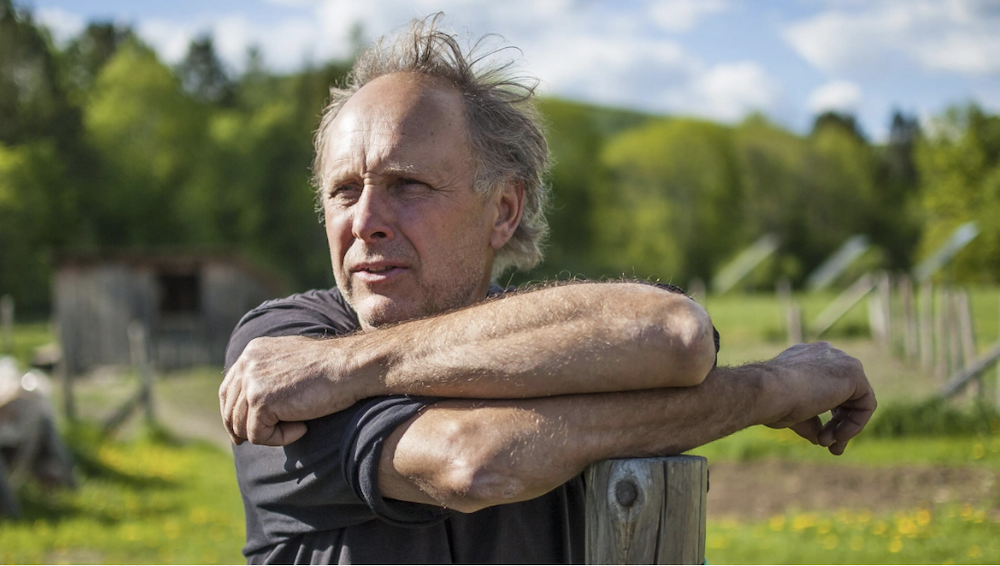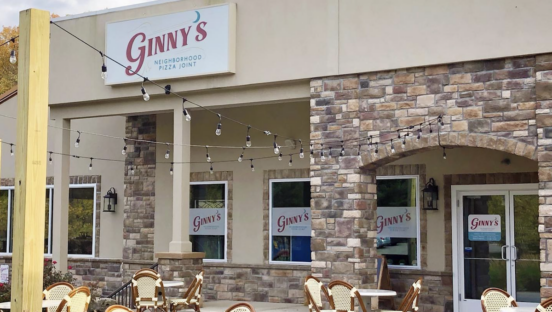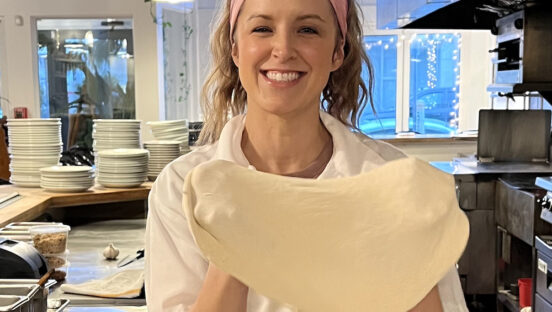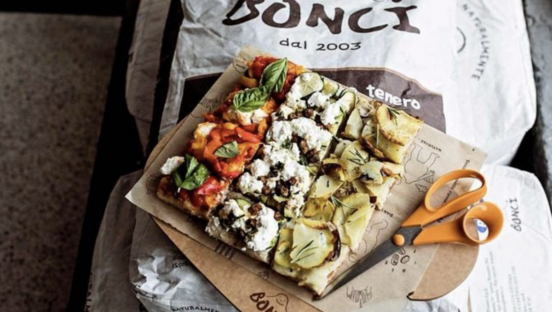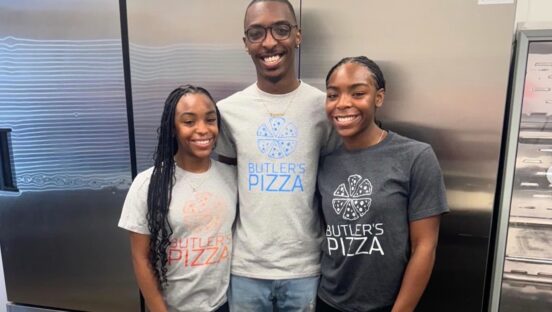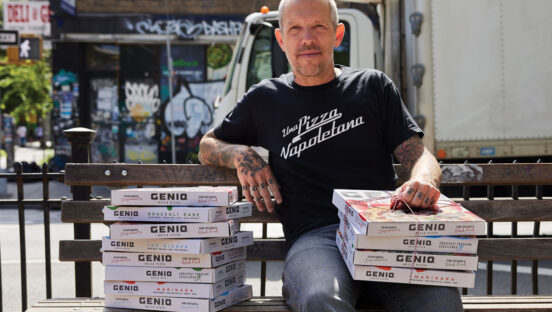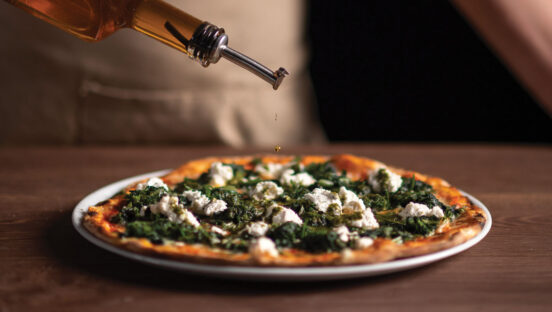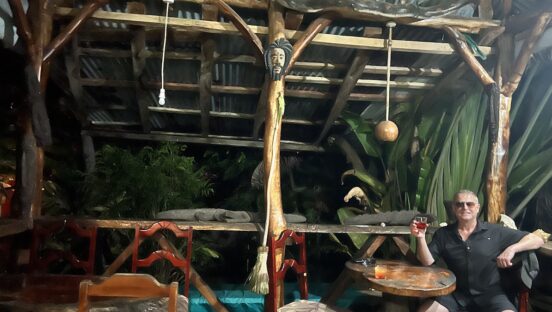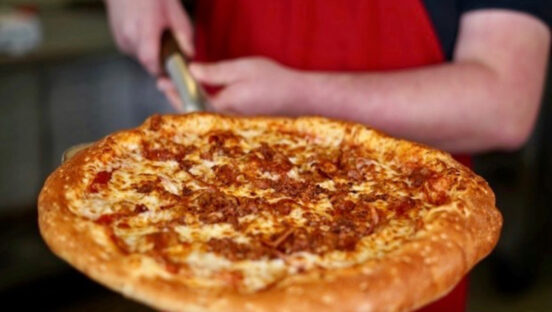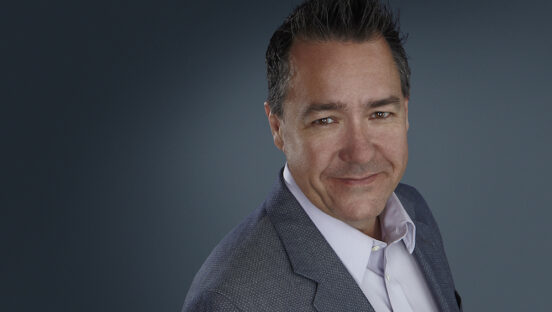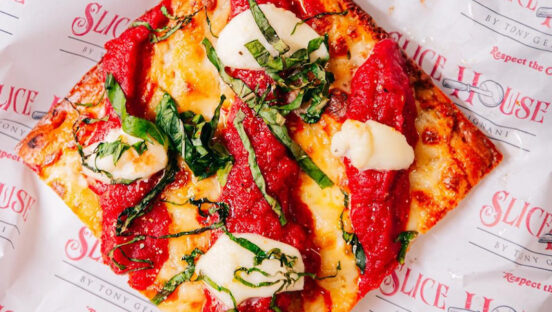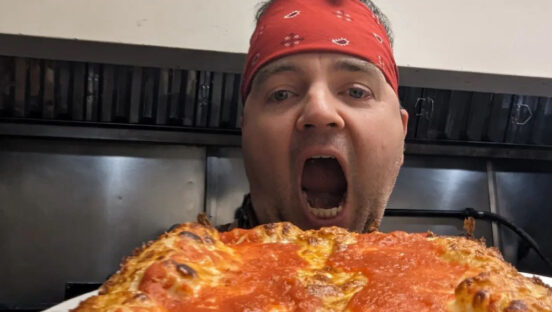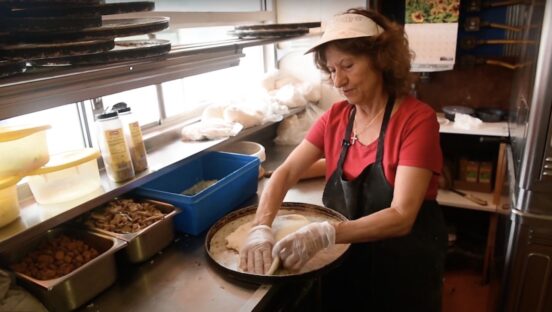By Charlie Pogacar
In the early 1980’s, George Schenk was a self-proclaimed ski bum. He held a degree in biological sciences, but found himself working a kitchen job during the offseason in Waitsfield, Vermont, a small ski town in the Mad River Valley. It was during this time that Schenk’s mother asked him a classic question familiar to so many recent college graduates.
“She asked me, ‘When are you going to start using your degree?’” Schenk recalled, speaking with PMQ via phone at his office at American Flatbread, an iconic Vermont pizza company he founded in 1985. “My fields of interest were in physiology and ecology, and those became central to what food meant in the 1980s. We were asking, ‘What does food mean to our bodies and our environment?’ And that ultimately informed my thinking on how to imagine flatbread constructively, to the health and well-being of people while also being respectful of environmental concerns.”
In other words, it was, in fact, Schenk’s education in the sciences—along with his general curiosity and entrepreneurial spirit—that led to the foundation of his trailblazing company, one that now claims 11 locations across New England. American Flatbread also lends its name to a successful line of frozen pizzas available at grocery stores nationwide.
Related: USA Today wants to find the best gluten-free pizza
American Flatbread is famous for its farm-to-table philosophy: There’s a garden at the company’s original location, American Flatbread at Lareau Farm in Waitsfield, that is responsible for much of the produce that tops the pies cooked to perfection in the restaurant’s stone earthen oven. Even the line of frozen pizzas is known for having clean, quality ingredients that push the price point above the competition, to where the product is competing with diners eating out rather than those buying a different brand of frozen pizza. In other words, American Flatbread’s frozen pizza is in a class of its own.

American Flatbread (Brian Mohr/EmberPhoto.com)
There were many forks in the road for Schenk and American Flatbread, ones that, if Schenk had chosen a different path, it’s safe to say the company would not exist today. For example, it was by complete chance that he ended up working at Tucker Hill Lodge in Waitsfield under the tutelage of future-acclaimed-chef Gary Danko. It was there, and at a couple other Waitsfield restaurants, that Schenk honed his cooking skills. In those kitchens, his love for food only grew.
It was even more serendipitous that, during travels in Europe with his soon-to-be-wife, Schenk came upon a stone earthen oven in a small village. “Up until then, I thought an earthen oven had to be brick,” Schenk recalled. “I didn’t know much about brick. Stone was something I was more familiar with. So when I got back [to Vermont], I was having another chef and his wife over for dinner, and I thought, ‘Maybe I’ll build my own adaption of the fireplaces I’d built in Boy Scouts to cook off of.’”
He ended up creating a makeshift stone earthen oven at his house in Waitsfield. His plan was to cook for his dinner guests—he couldn’t have known the heights to which this small oven would take him.
At the time, Schenk said, he didn’t know the first thing about pizza dough. He had made baguettes, though, and he knew the cold drafts that inhabit Vermont farmhouses during the winter hinder the bread-making process. To account for that, he flattened out some bread dough, making it nice and thin. He brushed it with olive oil, garlic, fresh herbs and some Parmesan cheese and tossed it in the oven. He didn’t know if the pizza would stick to the stone, or what the overall result might be. But when his wife and their guests began eating the flatbreads, the feedback was unanimous: Schenk had created something special.
Related: Tom Lehmann explains how to turn flatbread wraps into pizza skins
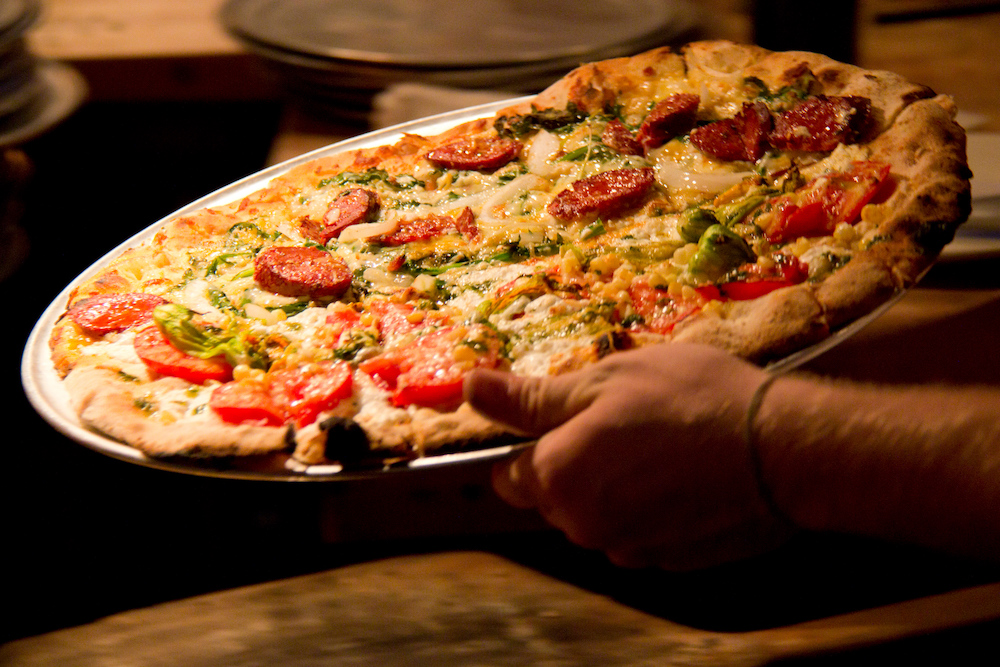
A modern American Flatbread. (Brian Mohr/EmberPhoto.com)
In experimenting, Schenk had also unlocked a bread-making process that was tens of thousands of years old. The American Flatbread website points out that the process of cooking flour and wheat on hot stone has been around for 75,000 years. Various civilizations all over the globe came to some version of flatbread based on their own respective experimentation. In Norway it was flatbrod; in China it was called po bin; in Scotland it was called oat cake, and so on and so forth.
“Flatbread was the solution to the problem of making nutritious grains both digestible and palatable,” Schenk said. “Whether that was here in the Americas where corn was the grain and the product was the tortilla…the idea was always the same: grind up the grain, mix it with fluid—most often water—then knead it, put it on hot stone…and have a fire underneath.”
After writing a proposal and having it approved by Danko, Schenk was soon cooking flatbread at Tucker Hill Lodge a couple of nights a week in another stone earthen oven he’d built on the restaurant’s patio. He was using the culinary standards of the white-table cloth restaurant and applying them to something that was much more approachable and scalable. This was important to him, and it traced back to his general fascination with how to feed large groups of people in a healthy and environmentally friendly way.
“One of the things I observed, working as an appetizer chef at Tucker Hill Lodge, was that the food we were doing in the 1980s was really pushing the envelope, it was really interesting stuff, but it was becoming increasingly expensive,” Schenk said. “As a result, we were increasingly excluding more and more of the population. Pizza is intrinsically not expensive to make, and, in that way, it is an efficient way to feed people. If we could [make pizza] but hold on to the core values of the food that’s meaningful and responsible to its environment, it struck me that we’d be able to imagine this in a much better way that was financially accessible to more people.”
It was again, almost by total chance, that frozen pizza became yet another way for Schenk to spread his increasingly popular flatbreads to the masses. A local IGA grocery store owner, Tom Mehuron, was a regular at Tucker Hill Lodge. Schenk convinced Mehuron to put 24 par-baked American Flatbread pies in the frozen foods section of his grocery store. Neither man really knew what would come of it, and they certainly didn’t know it would be such a revelation. But the next day, Mehuron called Schenk and told him the flatbreads had sold out in just a couple of hours. He wanted 110 more of them, as soon as possible.
Quite literally overnight, American Flatbread had been thrust into the frozen pizza business. Schenk began looking around for a place that could house a wholesale operation. He found a location at Lareau Farm, one of the oldest-running farms in the Mad River Valley, with roots back to the late 1700s. Not only did Lareau Farm become the site where American Flatbread’s wholesale operation would be based, but it is also where the company would open its first independent restaurant operation—the one that still stands to this day.
Related: Flatbreads deliver artisanal flair and the perception of healthier eating
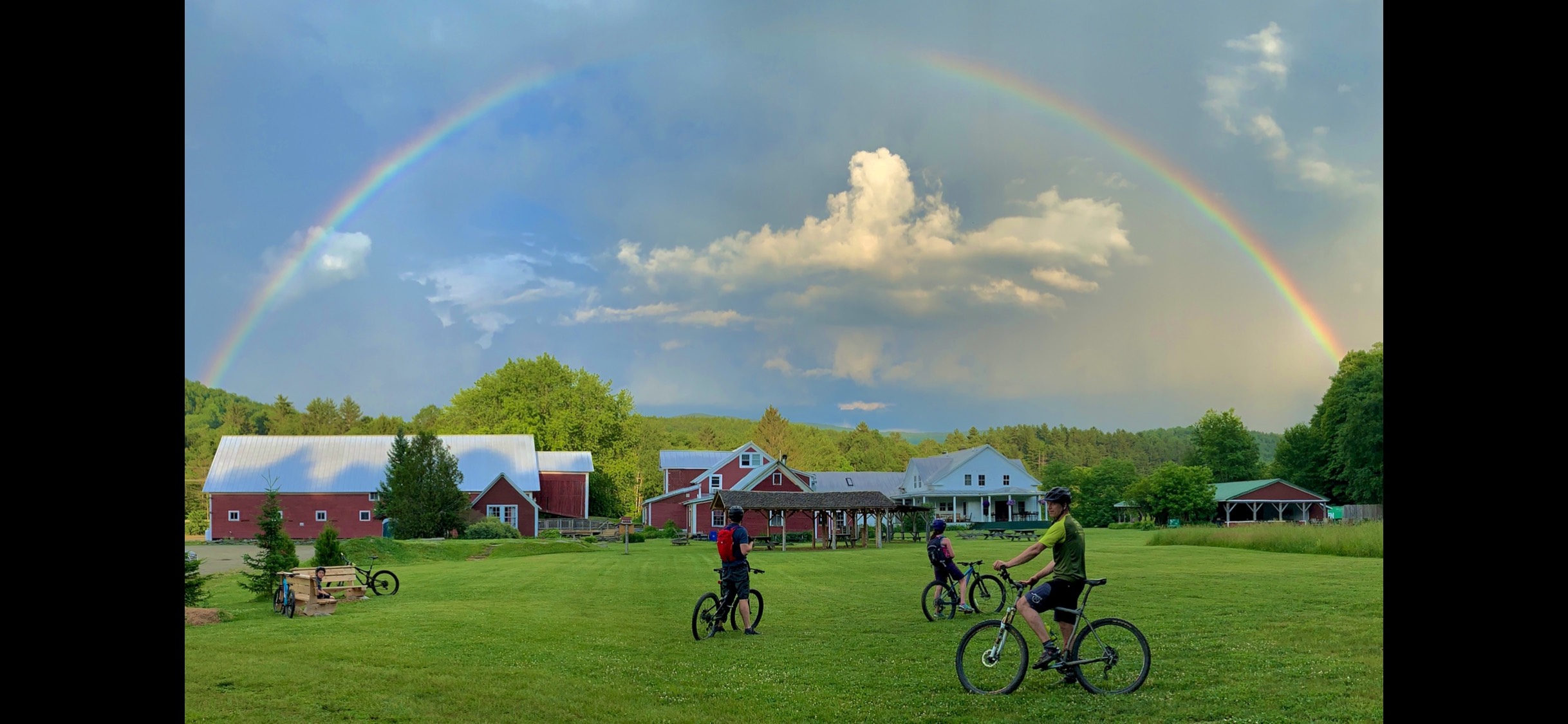
In June 1992, Schenk and American Flatbread finally moved out of Tucker Hill Lodge and into the facility at Lareau Farm that had housed the wholesale operation for the past year. They began using the site as a wholesale baking business Monday–Thursday, from 7 a.m. to 11 p.m. The facility would then convert into a restaurant for Friday- and Saturday-night service, and this rotation became the business model for many years to come—the farm would also become a coveted wedding and events venue, among other things.
Schenk had been receiving franchising inquiries for a number of years. He found it flattering and had some interest, but it wasn’t until somebody actually cut him a check that the process was initiated. In 1998, a second American Flatbread location was opened in Amesbury, Massachusetts, via a licensing agreement with a gentleman named Jay Gould.
It was a learning process for Schenk. He said he felt like he couldn’t afford legal advice at the time, but later learned he couldn’t afford to not have it. “I was wholly unprepared to be in the business,” Schenk said, adding that his high school classmates once voted him “least likely to go into business.”
Boy, did Schenk prove them wrong. Yes, American Flatbread took some lumps along the way, but the business has since grown all across New England—there are five restaurants in Vermont, four in Massachusetts, one in Connecticut, and one in Maine. While every store outside of the one in Waitsfield is a franchised location, each restaurant still cooks its scratch-made flatbread dough in a stone earthen oven on site. (It’s worth noting that American Flatbread’s line of frozen pizza was sold to an outfit based in New Hampshire several years back, and there are about 10 other once-affiliated restaurants that split off from American Flatbread Co. at some point).
Pizzas on the menu at American Flatbread locations include the Medicine Wheel, the brand’s take on a classic cheese pizza: homemade organic tomato sauce, whole-milk mozzarella, Parmesan and organic herbs. The Cheese and Herbs pie is a throwback to the first flatbread Schenk ever made, featuring whole-milk mozzarella, Parmesan, homemade garlic oil and a house blend of organic herbs. There’s an array of other flatbreads with wholesome ingredients and righteous-sounding names—Power to the People, for example, featuring chicken, buffalo sauce, red onion, carrot, blue cheese, mozzarella, Grana Padano and fresh herbs—and an array of salads and desserts that reflect the farm-to-table nature of the company.
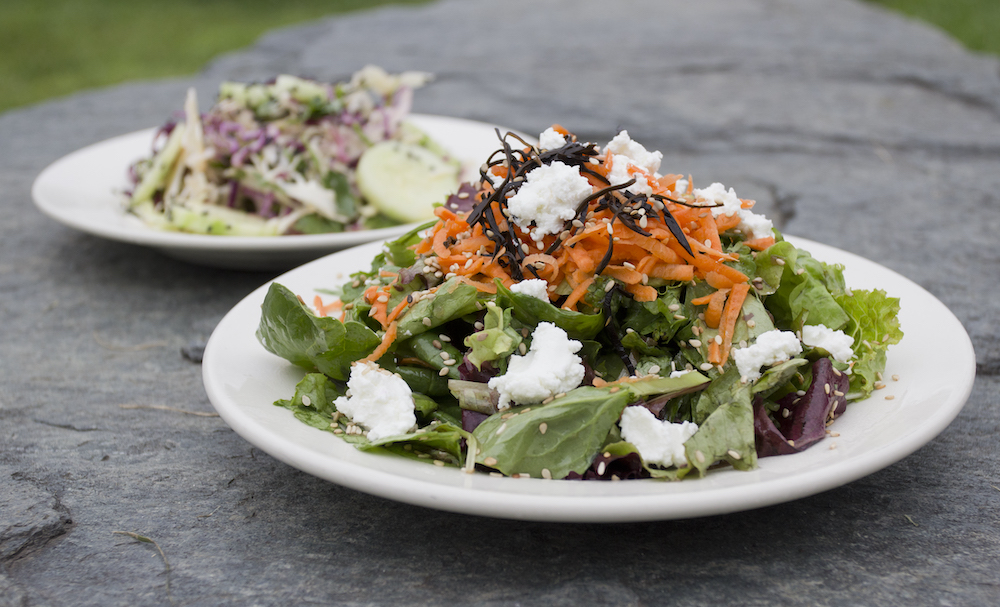
American Flatbread salad (Brian Mohr/EmberPhoto.com)
Reflecting back on the years spent building American Flatbread, Schenk said a couple of things stand out, both having to do with the company’s relationship with the local community. In 1993, Schenk founded the Medicine Wheel Bread Program, where grammar school kids are taught to make cheese flatbreads, ultimately donating them to patients at the children’s hospital at the University of Vermont. It’s yet another way to feed people great food that they’ll enjoy—in this case in a setting, a hospital, where they might not otherwise experience it.
This was one of the many ways American Flatbread has given back to its surrounding community, a core value that has always driven the company forward. It’s also a value that seemingly thrust karmic energy out into the world that has come full circle a number of times in the past several decades. Schenk wanted to help the community, but what he didn’t realize when he got into the pizza business was how often he’d need help from the community.
For example, in 1998, a flood badly damaged the original facility at Lareau Farm. It happened again when Hurricane Irene swept through Vermont in 2011, wreaking havoc on homes and businesses, especially those close to rivers. On both occasions, the community came out to help with the clean-up effort, ensuring American Flatbread would rise again.
“Pride is not a word I use very often,” Schenk said. “I tend to be grateful for an extraordinary opportunity. Sometimes it’s been really hard, but it’s been a wonderful journey. It’s been the relationships that remain meaningful and have given us a strong sense of place and a good, safe home. And for that I am profoundly grateful.”
Not bad for a ski bum with a science degree.
Charlie Pogacar is PMQ’s senior editor.

